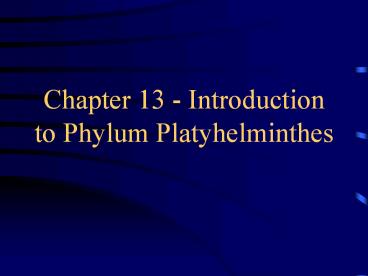Chapter 13 - Introduction to Phylum Platyhelminthes - PowerPoint PPT Presentation
1 / 9
Title:
Chapter 13 - Introduction to Phylum Platyhelminthes
Description:
Chapter 13 - Introduction to Phylum Platyhelminthes Chapter 13 - Introduction to Phylum Platyhelminthes General Characteristics Bilaterally symmetrical ... – PowerPoint PPT presentation
Number of Views:385
Avg rating:3.0/5.0
Title: Chapter 13 - Introduction to Phylum Platyhelminthes
1
Chapter 13 - Introduction to Phylum
Platyhelminthes
2
- General Characteristics
- Bilaterally symmetrical dorsoventrally
flattened - Acoelomates most of the body is comprised of
parenchyma, a collection of fibers and cell types
(sensory, food storage, etc.) internal organs
are embedded in the parenchyma muscle fibers are
also found running through the parenchyma - Unable to synthesize fatty acids and sterols de
novo
- Turbellaria and free-living stages (certain
larval stages) of Class Cestoidea and Trematoda
have ciliated epithelium
3
- General Characteristics cont.
- The nervous system does have a centralized
(ganglionated) area and a peripheral system
(arranged as a network or as a ladderlike system
with longitudinal nerve cords and transverse
commissures) - The digestive system is typically a blind sac
and most flatworms have a mouth near the anterior
end followed by a muscular pumping pharynx
4
- General Characteristics cont.
- Anus absent wastes are eliminated through the
mouth or via nephridiopores - In some the gut is a simple sac, while in others
it is finely branched structure some groups
(cestodes) the gut is lacking
- Osmoregulatory system is comprised of flame
cells or protonephridia water and waste exit the
body through pores called nephridiopores
5
- General Characteristics cont.
- Most species are monoecious, with cross
fertilization - In some turbellarians and cestodes groups sperm
transfer is by hypodermic impregnation
6
Platyhelminths Systematics Traditional
Classification Scheme 1. Class Turbellaria
Most free-living worms from terrestrial, FW and
marine environments 2. Class Monogenea All
parasitic, mainly ectoparasites of fishes (e.g.
found on the skin and gills) 3. Class Trematoda
All parasitic, mainly in the digestive tract of
vertebrates a. Subclass Digenea - at least a 2
host life cycle first host is a mollusc b.
Subclass Aspidogastrea - most with only one host
(mollusc) c. Didymozoidea - tissue
dwelling parasites of fish 4. Class Cestoidea
All parasitic in all classes of vertebrates
except agnathans most have an intermediate host
7
Characteristics of Revised Classification Scheme
- The subphylum Catenulida is a sister group of
the true Platyhelminthes - The main structural feature separating the
subphylum Catenulida from the subphylum
Euplatyhelminthes is the presence of a frontal
organ in all the latter Euplatyhelminthes also
possess dense dermal ciliature compared to
catenulids
8
- Revised Classification Scheme cont.
- Among the S.P. Euplatyhelminthes, the acoelomate
forms (Superclass Acoelomorpha) lack a
protonephridia and generally do not have a gut - The Superclasses Rhabditophora have some kind of
protonephtridia
9
Taxonomic groups that will be emphasized
Superclass Rhabditophora Class Trematoda
Subclass Aspidobothrea Subclass
Digenea Class Monogenea Class Cestoidea
Subclass Cestodaria Subclass Eucestoda































